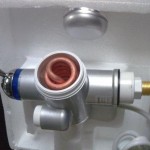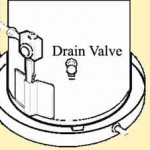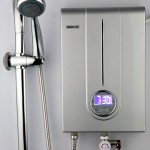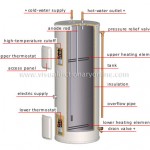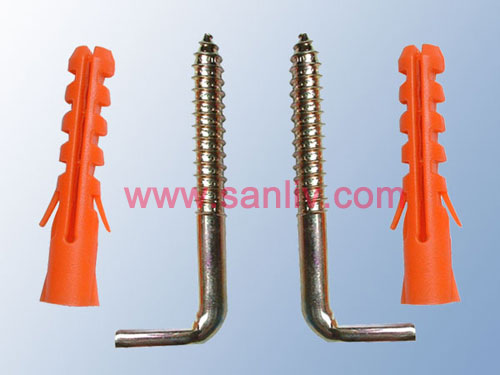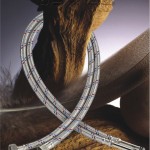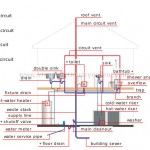Water Heater Problems troubleshooting, DIY hot water heater repair advice and tips. Expert advice on how to repair a hot water heater. Water heater problems normally become self-evident: A hot water faucet fails to summon hot water, you see dripping or puddles near the water heater, or the tank emits strange gurgling or popping sounds.
A water heater is the kind of home appliance most of us take for granted, but when you jump into the shower and are met with a blast of cold water, you know it’s time for hot water heater repair. This obviously isn’t a very pleasant experience, but it can be avoided if you are savvy with basic water heater maintenance. Let’s take a look at the anatomy of a water heater, how each part functions, and how they should be maintained and repaired.

The anatomy of a water heater: hot water supply line, gas vent and cold water input line.
A hot water heater is basically a storage tank that heats and then holds water. For a water tank to work, it needs a heat source (most commonly a gas fire but they can be electrically heated), a thermostat to regulate the temperature of the water, a cold water supply source and a hot water outlet to supply the home. It also has some other very necessary components. For safety, it has a vent for combustion gases, and a pressure relief valve (also known as a TPR valve, temperature pressure relief valve, or just relief valve), a safety device that releases pressure from the tank if either the internal temperature or pressure gets too high. For efficient operation, a hot water tank has an anode, a metal rod that prevents corrosion and helps eliminate smells from the water; a dip tube, which directs cold unheated water to the bottom of the tank; and a drain valve near the bottom of the tank so it can be emptied.
The repair work you can do on your hot water heater depends on how comfortable you are working with tools. At a minimum, any homeowner can drain and flush a water heater as well as test the TPR valve.
Water Heater Maintenance
Draining the water heater will help eliminate any build up of sediment inside the tank, and help keep the water smelling fresh. To drain the tank, first turn down the temperature and let the water in the tank cool for a couple of hours. Turn off the cold water supply, and attach one end of a hose to the bottom drain valve and run the hose to a drain or outside the house. Open a hot water faucet in the house to let air into the top of the tank, and then open the drain valve on the water tank. When all the water has drained from the tank, turn the cold water supply valve off and on a few times, essentially flushing any sediment out of the tank. When the water coming out the drain valve runs clear, disconnect the hose from the drain valve, close the valve and refill the tank. Don’t forget to turn off that faucet and turn the thermostat back up.
A water heater TPR valve.
Testing the TPR valve is simply a matter of manually raising or lowering its handle. The valve is usually attached on the top of the tank but some are on the side. Water should run out of the bottom of the tube and stop when the TPR valve is released.
Basic Hot Water Heater Repair
Problem: There’s no hot water.
Solution: Either the flame has gone out or the thermostat is not functioning.
• Vérifiez si le voyant est allumé. If it has gone out, it needs to be relit. This is something you can do yourself (follow the water heater manufacturer’s directions explicitly), or the gas supply company should relight the pilot for you.
• Vérifier le thermostat. Turn on a hot water tap and leave it running for a few minutes. The burner should light automatically as the thermostat recognizes the need to heat water. If it doesn’t, the thermostat is likely defective and will need to be replaced. Ce, unfortunately, is a job for a professional.
Problem: There’s not enough hot water.
Solution: The obvious first step is to check that your thermostat is set properly. If it is, have you flushed out the tank recently? A build up of deposits inside the tank could reduce its capacity, meaning you won’t have enough water for a long shower.
Another possibility is that the dip tube is broken. The dip tube is made of plastic and its job is to direct the incoming cold water to the bottom of the tank where it will be warmed before it mixes with the hot water already in the tank. If the dip tube has broken, incoming cold water may be mixing with the hot water in the upper part of the tank, lowering the overall water temperature. You can access the dip tube by removing the cold water supply plumbing and then gently lifting the dip tube out of the tank. Replacements are available.
Problem: The water is smelly.
Solution: The smell in your hot water likely comes from bacteria in the tank. Drain some water from the tank and then through the cold water input port. Add some hydrogen peroxide. Close up the system and then run some water from each tap and outlet (washing machine, dishwasher, etc.). The peroxide should kill the bacteria and eliminate the rotten eggs smell. Keeping the water temperature above 150 degrees should ensure no bacteria can grow, but if you have small children or elderly people in the home, this may not be a viable option due to the risk of scalding.
Performing water heater maintenance as suggested above will help keep your tank working. Basic hot water heater repair is also well within the skill of any homeowner. toutefois, moving beyond basic maintenance and repair can put your plumbing skills to the test, as well as bring you into contact with combustible gas or electricity and water, possible dangerous combinations. If you feel uncomfortable with any aspects of hot water heater repair, don’t do it. Au lieu, contact a professional.

